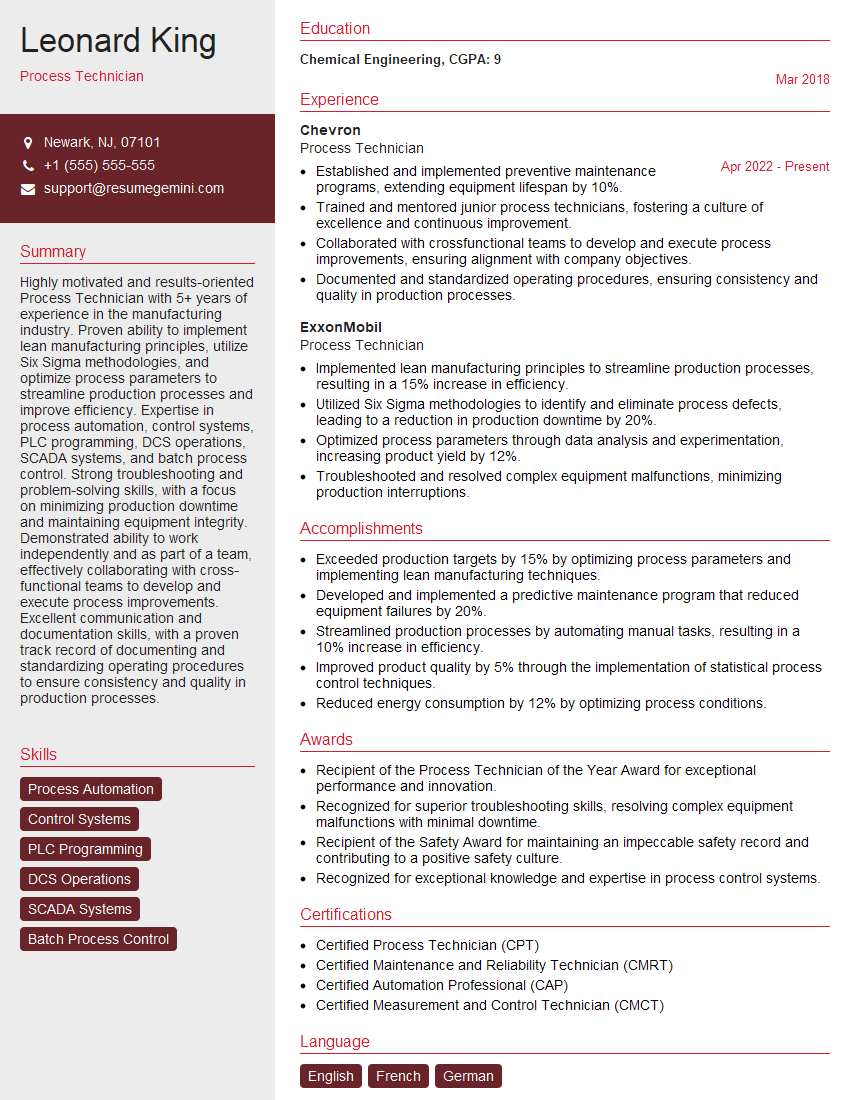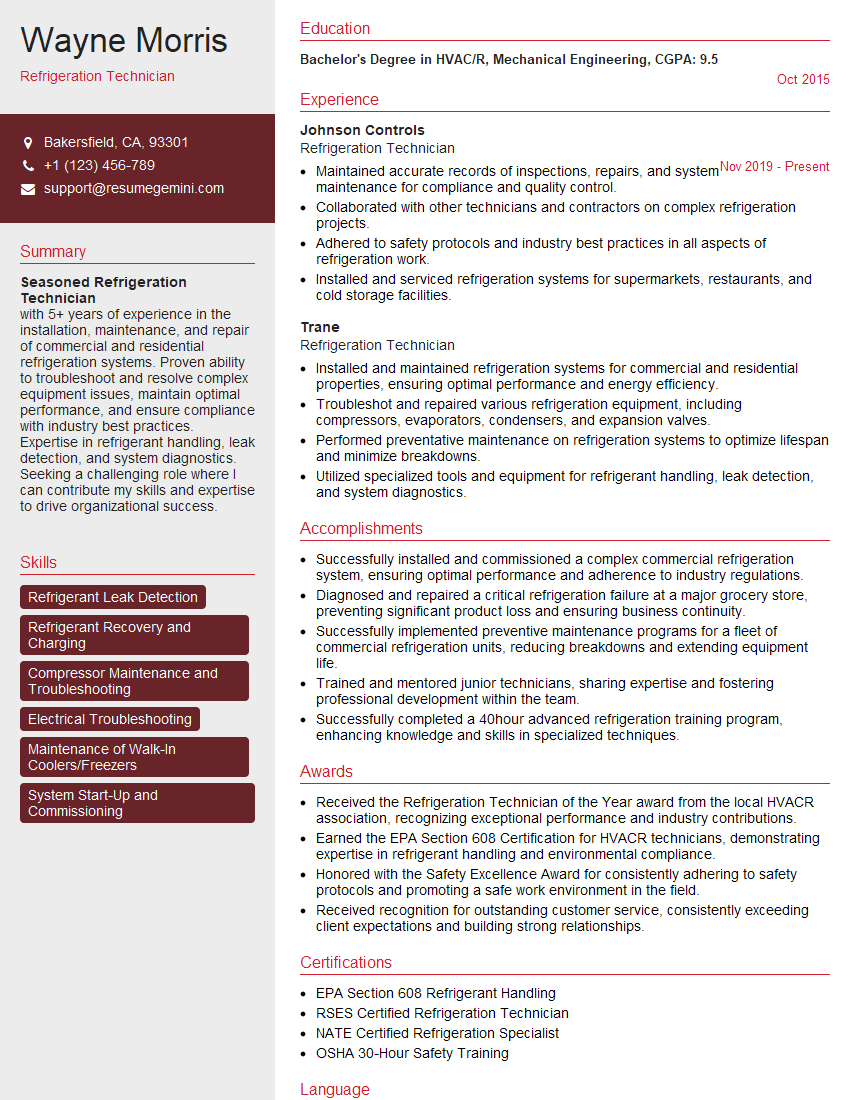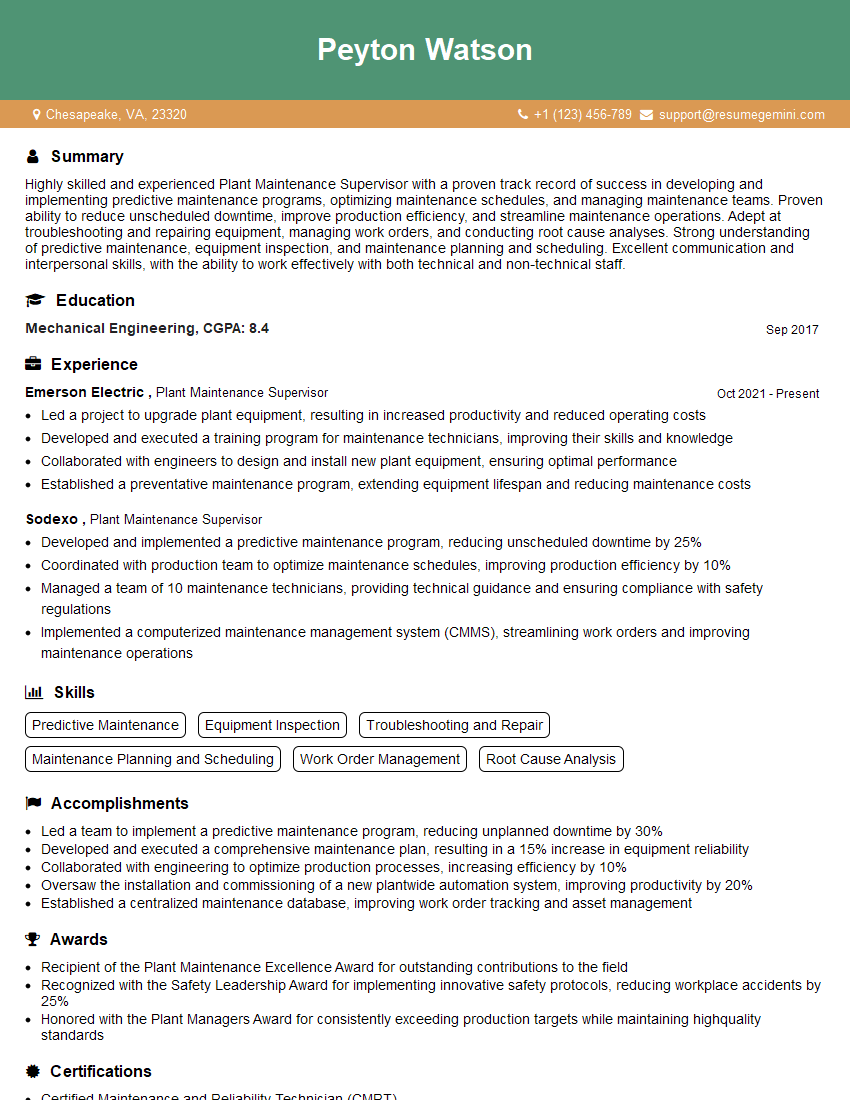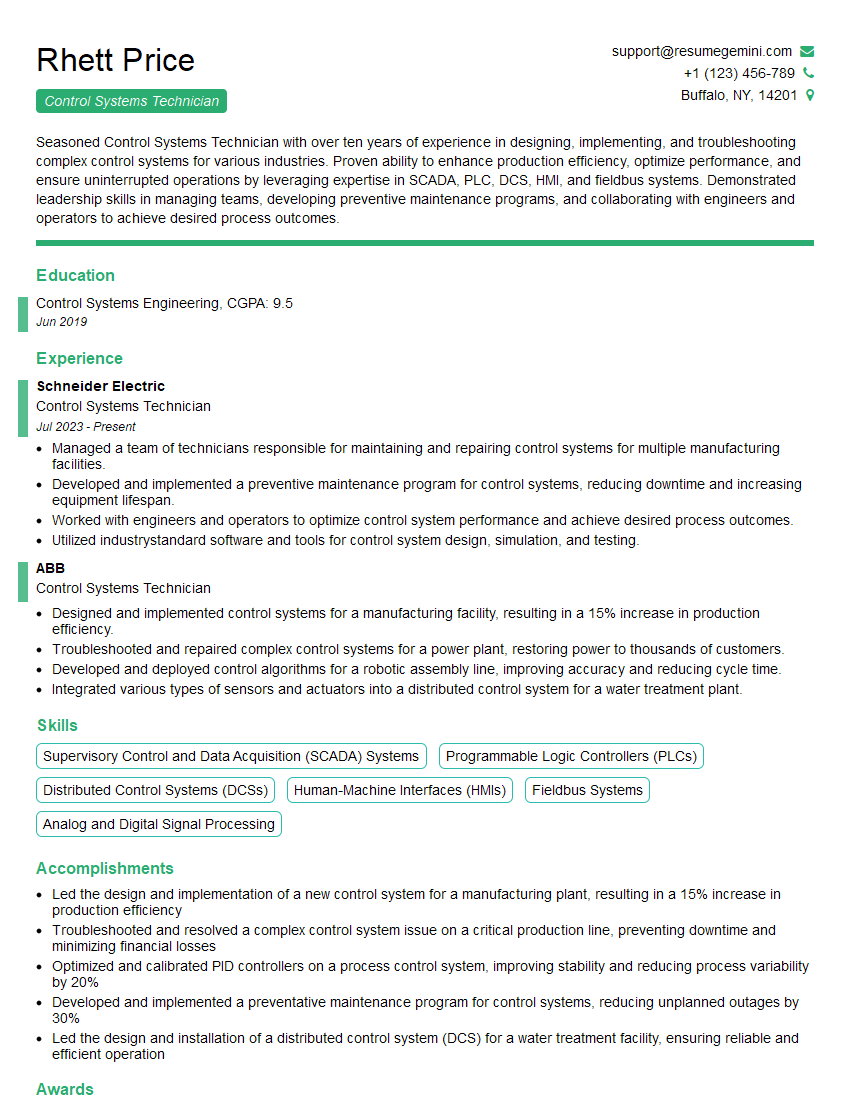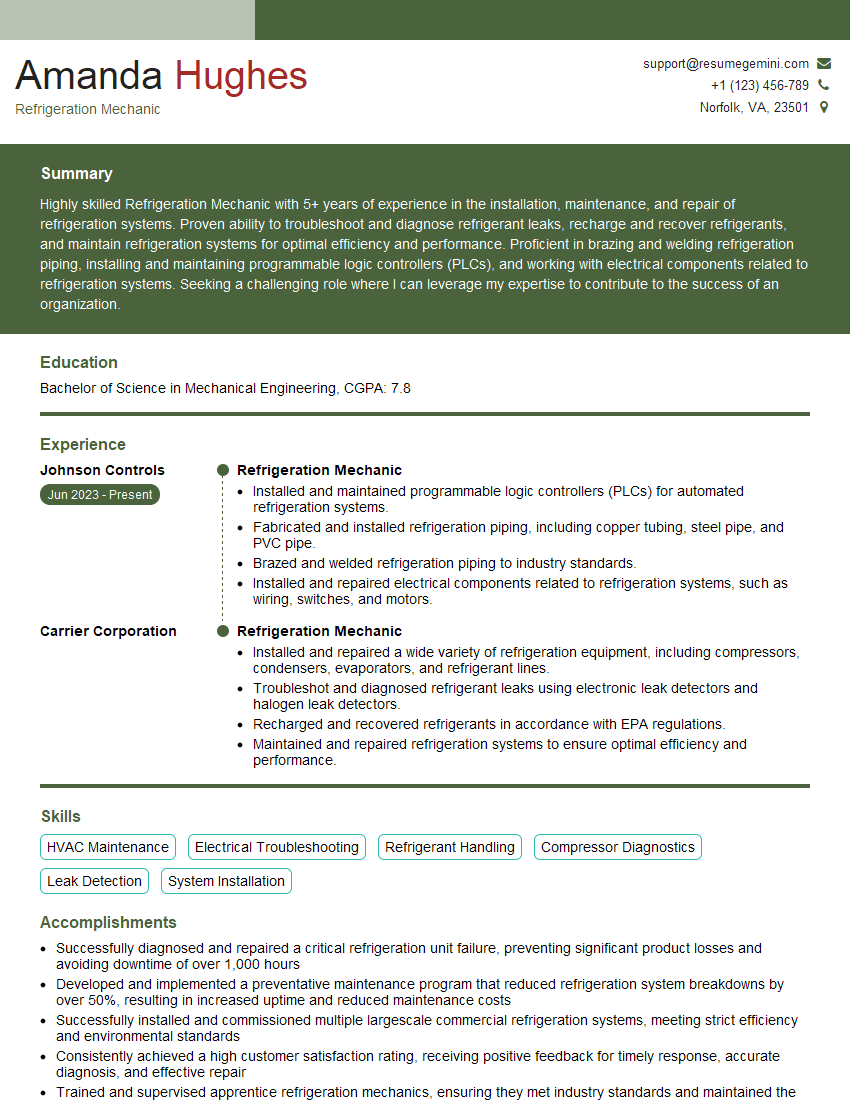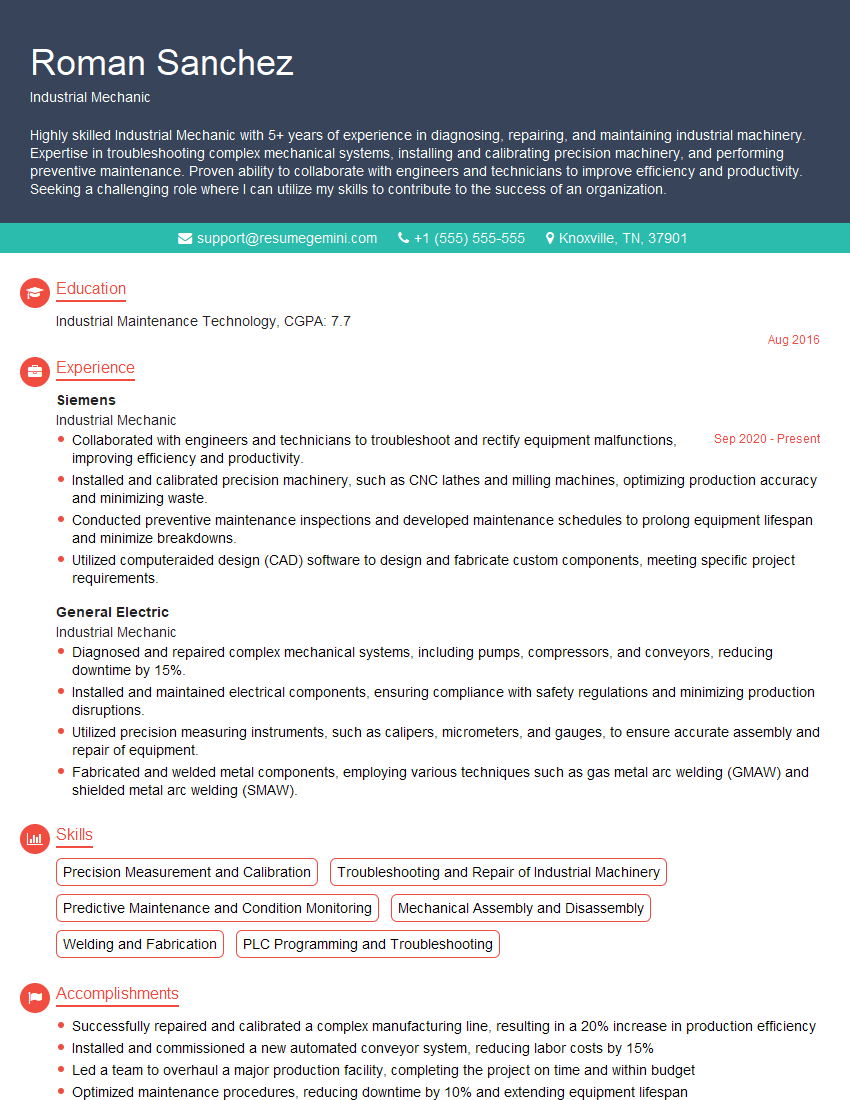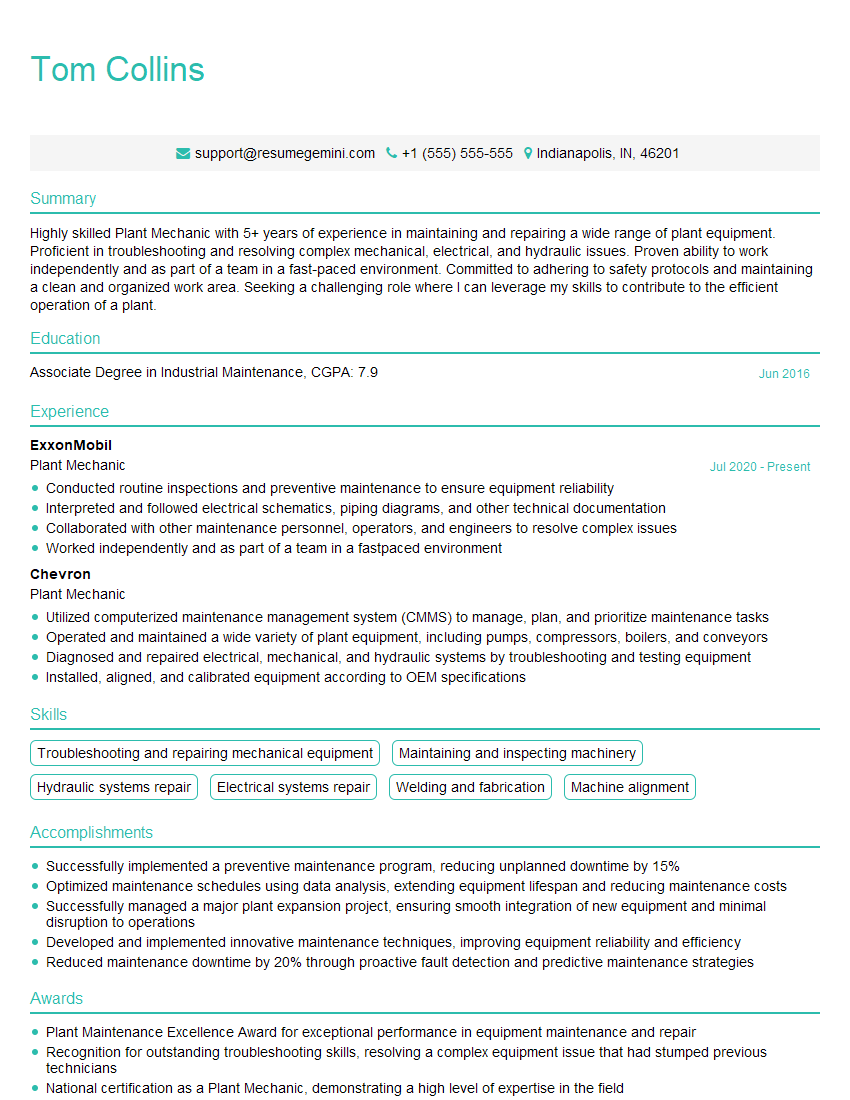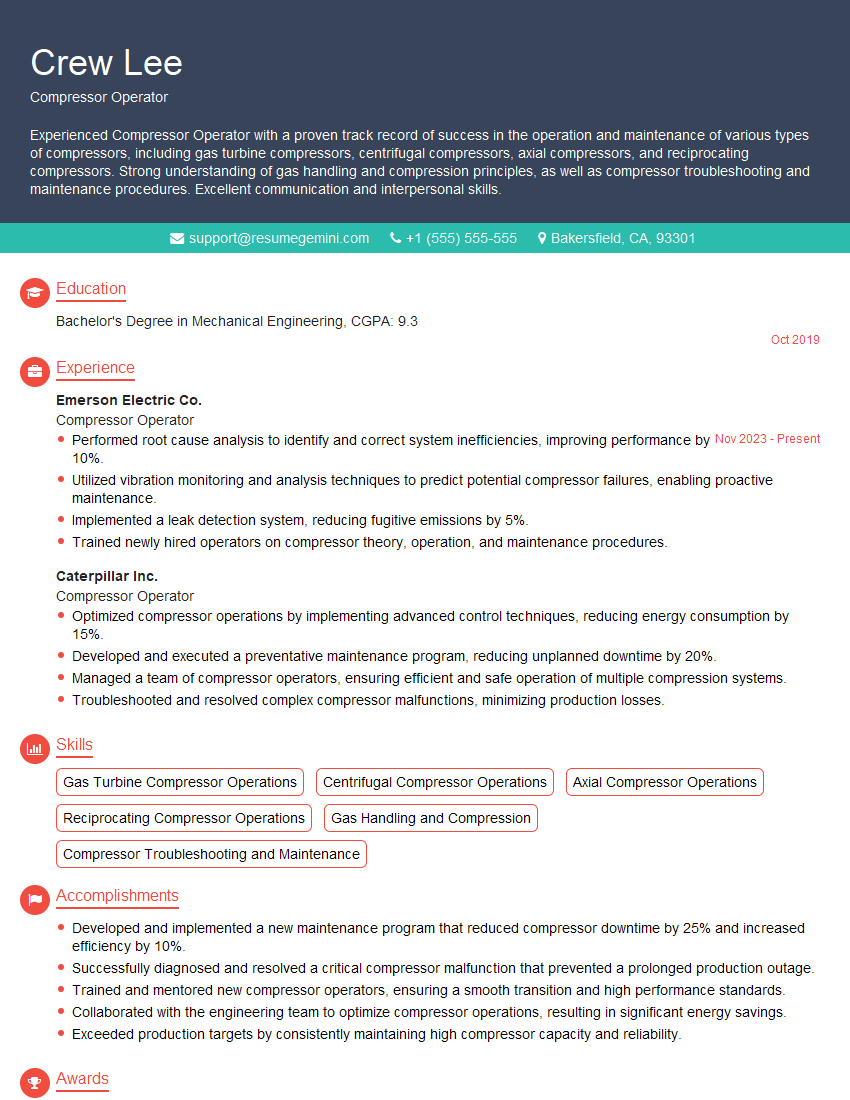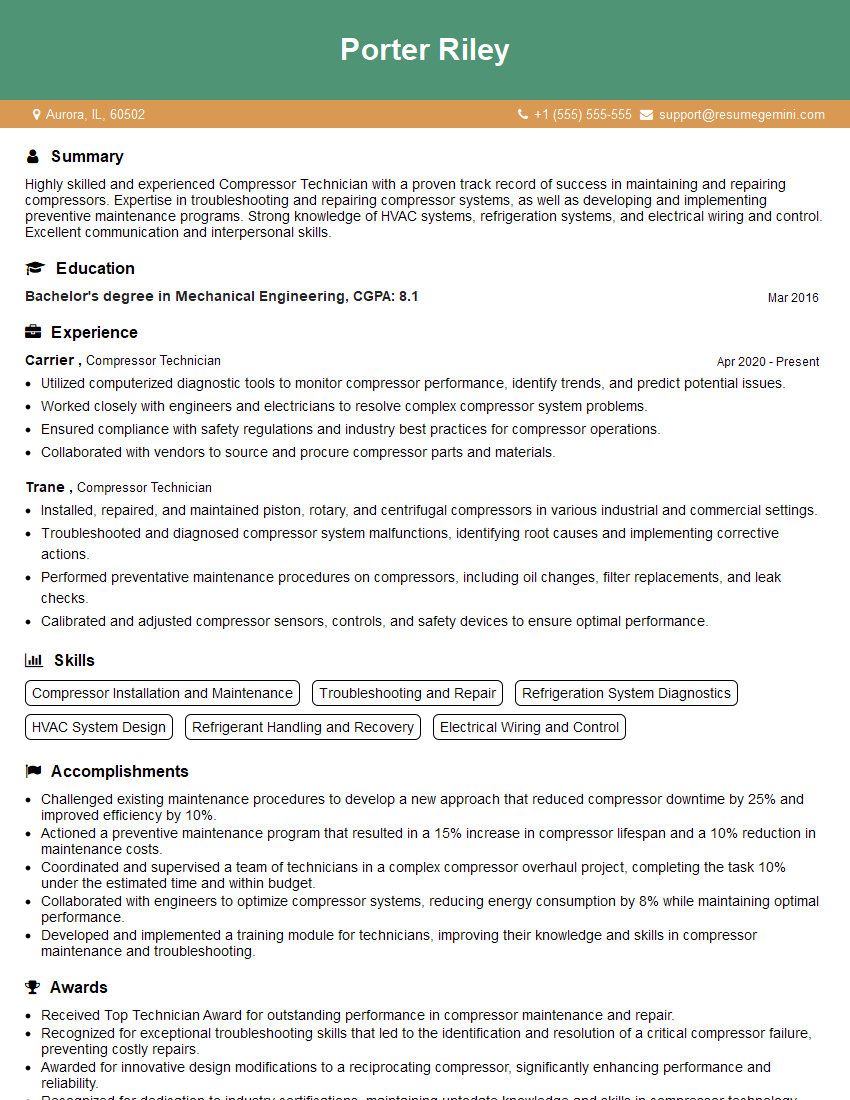Interviews are opportunities to demonstrate your expertise, and this guide is here to help you shine. Explore the essential Compressor Operation and Troubleshooting interview questions that employers frequently ask, paired with strategies for crafting responses that set you apart from the competition.
Questions Asked in Compressor Operation and Troubleshooting Interview
Q 1. Explain the different types of compressors.
Compressors are broadly classified based on their operating principle. The most common types include reciprocating, centrifugal, screw, and rotary vane compressors. Each type offers unique advantages and disadvantages making them suitable for different applications.
- Reciprocating Compressors: These use pistons moving back and forth within cylinders to compress gas. They are excellent for high-pressure applications but can be less efficient at high flow rates and tend to be noisier.
- Centrifugal Compressors: These use rotating impellers to accelerate and compress gas. They are known for their high flow rates and relatively smooth operation, making them ideal for large-scale applications like gas pipelines or power plants, but they generally operate at lower pressures than reciprocating compressors.
- Screw Compressors: These use two intermeshing helical rotors to compress gas. They offer a balance between high flow rates, relatively high pressure capability, and smooth operation. They are commonly used in industrial applications.
- Rotary Vane Compressors: These use vanes that slide in and out of slots within a rotor to compress gas. They are compact, relatively inexpensive, but generally suitable for lower pressure and flow rate applications.
The choice of compressor type depends heavily on factors such as the required pressure and flow rate, the type of gas being compressed, the budget, and the noise tolerance level.
Q 2. Describe the working principle of a reciprocating compressor.
A reciprocating compressor works by using a piston to repeatedly reduce the volume of gas within a cylinder, thereby increasing its pressure. Imagine a bicycle pump: you push the piston down, reducing the volume of air inside the cylinder and increasing its pressure. The compressed gas is then released through an outlet valve.
The process typically involves an intake stroke where the piston moves away from the cylinder head, drawing in gas; a compression stroke where the piston moves towards the cylinder head, compressing the gas; and a discharge stroke where the compressed gas is pushed out through a valve.
To enhance efficiency, many reciprocating compressors use multiple cylinders and stages, allowing for more continuous operation and higher pressure ratios. This also helps to balance the pulsating flow produced by individual cylinders.
Q 3. How does a centrifugal compressor work?
A centrifugal compressor uses rotating impellers to accelerate gas, increasing its kinetic energy. This high-velocity gas is then slowed down in a diffuser, converting kinetic energy into pressure energy. Think of a fan: it accelerates the air, creating a pressure difference.
The impeller, a set of curved blades, imparts momentum to the gas as it flows radially outward. The increased velocity is then converted to pressure as the gas flows through the diffuser, a carefully designed passage that gradually slows the gas down. Multiple stages, each with an impeller and diffuser, can be used to achieve very high pressure ratios.
Centrifugal compressors are known for their high flow rate capacity and suitability for low-to-medium pressure applications. They are quieter and smoother running than reciprocating compressors, making them preferable in many industrial situations.
Q 4. What are the key components of a screw compressor?
The key components of a screw compressor are the two helical rotors, the gearbox, the oil system, and the control system.
- Helical Rotors: These two intermeshing rotors are the heart of the compressor. They draw gas in, compress it, and discharge it without valves. Their precise design is crucial for efficient operation.
- Gearbox: The gearbox maintains the correct rotational speed and synchronization between the two rotors. Without precise synchronization, the rotors would rub and cause damage.
- Oil System: The oil system plays a crucial role in lubricating the rotors, sealing the compression chambers, and cooling the components. Oil is critical to the operation of a screw compressor.
- Control System: This monitors the compressor’s operation, managing the pressure, temperature, and oil levels. Modern control systems use sensors and algorithms to optimize performance and prevent problems.
The interaction of these components determines the overall efficiency and performance of the screw compressor.
Q 5. Explain the role of lubrication in compressor operation.
Lubrication is absolutely vital in compressor operation. It serves multiple critical functions:
- Reduces Friction: Oil lubricates moving parts (pistons, rotors, bearings), reducing friction and wear, thus extending component life.
- Cooling: Oil absorbs heat generated during compression, keeping components within safe operating temperatures and preventing overheating.
- Sealing: In some designs, oil helps seal the compression chambers, preventing gas leakage and maintaining compression efficiency.
- Corrosion Prevention: Oil protects components from corrosion, particularly important in humid environments or when dealing with certain gases.
Inadequate lubrication can quickly lead to catastrophic failures, such as bearing seizures or rotor damage. Regular oil changes and monitoring of oil condition are critical for reliable compressor operation.
Q 6. How do you identify a compressor malfunction?
Identifying a compressor malfunction requires a systematic approach. You should start by monitoring key parameters like:
- Pressure: Consistently high or low pressure indicates a potential problem with the compressor or its control system.
- Temperature: High temperatures suggest potential issues such as insufficient lubrication, blockage, or mechanical problems.
- Oil Level and Condition: Low oil levels or contaminated oil are serious indicators of potential issues requiring immediate attention.
- Vibration: Excessive vibration indicates potential problems with bearings, rotors, or other rotating components.
- Unusual Noises: Rattling, knocking, or squealing sounds indicate potential mechanical problems.
If any anomaly is detected, a thorough inspection should be performed, including visual checks, and specialized tools and diagnostics might be necessary to identify the root cause.
Q 7. Describe common compressor problems and their causes.
Common compressor problems and their causes vary depending on the compressor type but some common issues include:
- Valve Problems (Reciprocating): Leaking or sticking valves can lead to reduced efficiency and pressure. This might be due to wear, debris, or incorrect adjustment.
- Bearing Failure: Worn or damaged bearings cause vibrations, noise, and eventual failure. Causes include insufficient lubrication, overloading, or age.
- Rotor Damage (Screw & Centrifugal): Damage to rotors can be caused by insufficient lubrication, ingestion of foreign objects, or operating outside of design parameters.
- Lubrication Issues: Insufficient or contaminated oil can cause wear, overheating, and premature failure of various components. This is a common issue with all types of compressors.
- Seal Leaks: Leaking seals lead to reduced efficiency and gas leakage. Causes might include wear, damage, or incorrect installation.
Troubleshooting these problems usually involves a combination of visual inspection, diagnostic tests, and component replacement or repair. The specific solution depends heavily on the root cause, the compressor type, and the extent of the damage.
Q 8. What are the safety precautions when working with compressors?
Working with compressors, especially high-pressure systems, presents significant safety risks. Always prioritize safety by following these precautions:
- Lockout/Tagout (LOTO): Before performing any maintenance or repair, always implement LOTO procedures to prevent accidental startup. This involves isolating the power source and physically locking out the controls.
- Personal Protective Equipment (PPE): Wear appropriate PPE, including safety glasses, hearing protection, and sturdy work gloves. For high-pressure systems, consider specialized safety gear like impact-resistant footwear and a hard hat.
- Ventilation: Ensure adequate ventilation in the work area to prevent the buildup of harmful gases or fumes. Compressors can release oil mist and refrigerant, which can be hazardous.
- Pressure Relief Valves: Regularly inspect pressure relief valves to ensure they are functioning correctly. A malfunctioning valve could lead to catastrophic equipment failure.
- Fire Safety: Compressors often use flammable refrigerants or lubricants. Keep fire extinguishers readily available and know how to use them. Understand the fire hazards associated with the specific refrigerant used in your compressor.
- Training and Competency: Only trained and qualified personnel should operate and maintain compressors. Ensure that you receive adequate training before handling any compressor system.
For example, I once witnessed a near-miss where a technician forgot to lockout a compressor before performing maintenance. Luckily, no one was injured, but it highlighted the critical importance of LOTO procedures.
Q 9. How do you perform routine maintenance on a compressor?
Routine maintenance is crucial for extending the lifespan and ensuring the efficient operation of a compressor. A typical maintenance schedule includes:
- Oil Changes: Change the compressor oil according to the manufacturer’s recommendations. Using the correct oil viscosity is essential for proper lubrication and preventing damage.
- Filter Replacement: Regularly replace air filters and oil filters to prevent contaminants from entering the system. Dirty filters can significantly reduce efficiency and lead to premature wear.
- Belt Inspections: Check drive belts for wear, cracks, or slippage. Replace belts that show signs of significant degradation. Proper belt tension is crucial for optimal performance.
- Pressure Switch Calibration: Verify the accuracy of the pressure switch to ensure the compressor cycles correctly. An improperly calibrated switch can lead to premature wear or compressor failure.
- Leak Detection: Regularly inspect for leaks in the system, including oil leaks, refrigerant leaks (if applicable), and air leaks. Leaks can reduce efficiency and pose safety hazards.
- Cooling System Check: Inspect the cooling system, including fans and radiators (if applicable), for proper functioning. Overheating is a common problem, so ensuring efficient cooling is essential.
Think of it like maintaining your car – regular oil changes, filter replacements, and other checks are vital to prevent costly repairs and keep it running smoothly. A well-maintained compressor will save you money in the long run.
Q 10. Explain the importance of regular compressor inspections.
Regular compressor inspections are essential for preventing unexpected downtime, ensuring safety, and optimizing efficiency. Inspections help identify potential problems before they escalate into major failures. This proactive approach helps to:
- Prevent Catastrophic Failures: Early detection of issues like worn bearings, cracked components, or refrigerant leaks can prevent costly and potentially dangerous failures.
- Extend Equipment Life: Regular maintenance prevents premature wear and tear, significantly extending the operational life of the compressor.
- Improve Efficiency: A well-maintained compressor operates more efficiently, reducing energy consumption and operating costs.
- Enhance Safety: Identifying potential safety hazards during inspections helps prevent accidents and injuries.
- Maintain Compliance: Regular inspections often meet regulatory requirements and ensure compliance with industry standards.
Imagine finding a small crack in a pressure vessel during a routine inspection. If left unnoticed, this crack could potentially lead to a major rupture and a significant safety hazard. Regular inspections allow for timely repairs and prevent such disastrous events.
Q 11. What are the different types of compressor controls?
Compressor controls regulate the operation of the compressor, ensuring efficient and safe operation. Different types of controls exist, each with its own advantages and applications:
- Pressure-Based Controls: These are the most common type, using pressure switches to start and stop the compressor based on system pressure. A simple on/off system.
Example: When tank pressure drops below a set point, the pressure switch activates the compressor. When the pressure reaches a high-pressure set point, the compressor switches off. - Time-Based Controls: These controls cycle the compressor on and off at regular intervals, regardless of pressure. Useful in applications with relatively constant demand.
- Load-Based Controls: These more sophisticated controls adjust compressor operation based on the actual demand. They are more energy-efficient as they only run the compressor when needed.
- Variable Speed Drives (VSDs): VSDs allow for stepless control of compressor speed, optimizing performance and energy efficiency. They are more complex and expensive but offer significant advantages in certain applications.
- PLC-Based Controls: Programmable Logic Controllers (PLCs) offer advanced control capabilities, allowing for complex automation and integration with other systems. They’re ideal for large or complex compressor systems.
The choice of control system depends heavily on the specific application, desired level of efficiency, and complexity of the system. For a simple air compressor in a workshop, a pressure-based system might suffice. A large industrial refrigeration system, however, would likely benefit from a PLC-based system with VSDs for optimal control.
Q 12. How do you troubleshoot a compressor that is not starting?
Troubleshooting a compressor that won’t start involves a systematic approach. Here’s a step-by-step guide:
- Check the Power Supply: Ensure that the compressor is receiving power. Check the circuit breaker, fuses, and power cord.
- Inspect the Start/Stop Controls: Examine the pressure switch, overload relay, and other controls for proper operation. Test the controls with a multimeter if necessary.
- Examine the Motor: Look for any signs of damage to the motor, such as burnt windings or loose connections. Test the motor windings for continuity using a multimeter.
- Check for Blocked Intake: Ensure that the air intake is not blocked by debris or ice (in the case of refrigerated compressors).
- Verify Unloading System (if applicable): If the compressor has an unloading system, check to make sure it’s functioning correctly. A stuck unloading valve can prevent startup.
- Check the Oil Level: Low oil levels can cause a compressor to fail to start.
For instance, if the motor doesn’t hum, you may have a power supply issue. If it hums but doesn’t turn, there may be a problem with the starting capacitor or motor windings. A methodical check eliminates potential problems one by one.
Q 13. How do you troubleshoot a compressor that is overheating?
An overheating compressor is a serious issue that can lead to damage. Here’s how to troubleshoot it:
- Check Cooling System: Inspect fans, radiators, and cooling fins for obstructions or damage. Ensure that airflow is not restricted.
- Verify Ambient Temperature: Is the ambient temperature excessively high? High ambient temperatures can contribute to overheating.
- Inspect Oil Level and Condition: Low oil levels or contaminated oil can lead to overheating. Check the oil level and its condition. Dirty oil will reduce cooling efficiency.
- Examine the Pressure Relief Valve: Ensure the pressure relief valve is functioning correctly. A blocked or malfunctioning valve can cause excessive pressure and overheating.
- Check for Internal Leaks: Leaks in the refrigerant lines (in refrigeration compressors) can lead to overheating due to reduced cooling capacity.
- Inspect Motor Windings: Overheating can also be caused by faulty motor windings. Check for signs of burning or damage.
An analogy is a car overheating – you’d check the coolant level, radiator, and fan. Similarly, with a compressor, addressing potential cooling problems systematically often pinpoints the source of the issue.
Q 14. How do you troubleshoot a compressor that is losing oil?
Oil loss in a compressor can be due to several factors. Troubleshooting steps are as follows:
- Check Oil Level: First, determine the extent of oil loss. A small leak might be manageable, while significant oil loss requires immediate attention.
- Inspect Oil Lines and Fittings: Carefully examine all oil lines, fittings, and seals for cracks, leaks, or loose connections. Look for oil stains or wet spots.
- Check the Oil Cooler: If equipped with an oil cooler, check for leaks or damage. A leaking oil cooler can cause significant oil loss.
- Inspect Crankcase Seals: Worn or damaged crankcase seals can allow oil to leak from the compressor. These seals are crucial to prevent oil loss.
- Check the Oil Separator: The oil separator prevents oil from escaping with the compressed air. A malfunctioning oil separator will lead to oil loss in the compressed air system.
- Consider Internal Damage: In some cases, internal damage to the compressor (e.g., worn piston rings, scored cylinder walls) can cause significant oil loss. This often requires a professional assessment.
Remember to always use the correct type and grade of oil recommended by the manufacturer. Incorrect oil can lead to premature wear and seal failure.
Q 15. How do you troubleshoot a compressor with low output?
Low compressor output can stem from various issues. Think of it like a water pump – if the output is low, we need to check the entire system, not just the pump itself. Troubleshooting starts with systematically checking key areas:
- Intake Restrictions: Is there a blockage in the intake air filter or piping? Clogged filters significantly reduce airflow, mimicking low output. Imagine trying to suck water through a straw almost completely blocked – very little will come through.
- Discharge Restrictions: Examine the discharge piping and valves for obstructions or excessive pressure drop. A partially blocked discharge acts like a kink in a garden hose, restricting water flow.
- Internal Compressor Issues: This could involve worn piston rings (in reciprocating compressors), damaged valves, or a malfunctioning control system. A worn piston ring is like a leaky bucket – it can’t effectively transfer the air or gas.
- Lubrication Problems: Insufficient lubrication leads to increased friction and reduced efficiency. Imagine trying to turn a bicycle wheel with dry bearings; it’s hard work and not very effective.
- Cooling System Problems: Overheating reduces compressor efficiency. The cooling system ensures the compressor operates within its safe temperature range. This is like needing to let a car engine cool down to avoid overheating and causing damage.
A systematic approach – checking intake, discharge, internal components, and cooling – is crucial for effective troubleshooting. Using pressure gauges and temperature sensors to systematically check each part gives concrete data. Sometimes, a visual inspection alone can reveal the problem; other times, more advanced diagnostic tools are necessary. Remember to always follow safety procedures before undertaking any maintenance work on a compressor.
Career Expert Tips:
- Ace those interviews! Prepare effectively by reviewing the Top 50 Most Common Interview Questions on ResumeGemini.
- Navigate your job search with confidence! Explore a wide range of Career Tips on ResumeGemini. Learn about common challenges and recommendations to overcome them.
- Craft the perfect resume! Master the Art of Resume Writing with ResumeGemini’s guide. Showcase your unique qualifications and achievements effectively.
- Don’t miss out on holiday savings! Build your dream resume with ResumeGemini’s ATS optimized templates.
Q 16. What is the significance of compressor discharge temperature?
Compressor discharge temperature is a critical indicator of compressor health and efficiency. A high discharge temperature suggests potential problems, acting as a warning signal, much like a fever is a warning signal for illness. Several factors influence it:
- Excessive Compression Ratio: If the compressor is compressing gas to a significantly higher pressure than designed, the temperature will rise sharply. Imagine a bicycle pump; the more you compress the air, the hotter it gets.
- Cooling System Malfunction: An inefficient cooling system will result in higher-than-normal discharge temperatures, causing overheating.
- Internal Leakage: Internal leakage (like a leak in the piston seals of a reciprocating compressor) increases the work done by the compressor, leading to higher discharge temperatures. Think of it as increased friction due to parts rubbing together.
- Lubrication Issues: Insufficient or poor quality lubrication causes increased friction and heat generation.
- Valve Problems: Faulty valves can create increased back pressure and result in higher temperatures.
Monitoring discharge temperature provides real-time insights into the compressor’s operational status. High temperatures indicate a need for immediate attention to prevent damage or failure.
Q 17. Explain the concept of compressor efficiency.
Compressor efficiency refers to how effectively the compressor converts the input power into compressed gas. It’s a measure of how much useful work is done for the energy consumed, much like fuel efficiency in a car measures how many miles you can travel per gallon of fuel. It’s typically expressed as a percentage:
Efficiency = (Power Output / Power Input) x 100%
Power output is the power delivered to the compressed gas, while power input is the power consumed by the compressor. Several factors influence efficiency:
- Compressor Design: The type of compressor (reciprocating, centrifugal, screw), its internal design, and manufacturing quality influence efficiency. Some designs are inherently more efficient than others.
- Operating Conditions: Operating parameters like inlet pressure, discharge pressure, and gas temperature significantly impact efficiency. Optimal performance often involves a specific operating range.
- Maintenance: Regular maintenance, including lubrication, cleaning, and valve adjustments, directly influences efficiency. Neglecting maintenance leads to reduced efficiency over time.
High efficiency is desirable for cost savings and reduced energy consumption. Regular monitoring of efficiency metrics is essential for maintaining optimal performance and identifying potential problems early on.
Q 18. How do you interpret a compressor’s performance data?
Interpreting compressor performance data involves analyzing various parameters to assess its health and efficiency. This is similar to a doctor reviewing medical test results to understand a patient’s health. Key parameters include:
- Pressure Readings (Inlet and Outlet): These provide critical information about compression ratio and potential blockages.
- Temperature Readings (Inlet, Intermediate, Outlet): These identify overheating issues or cooling system problems.
- Flow Rate: Indicates whether the compressor is meeting its expected output.
- Power Consumption: Allows calculation of efficiency and detection of unusual energy usage.
- Vibration Levels: High vibration levels often indicate mechanical problems that could lead to failures.
- Oil Condition: Analysis of oil samples can reveal wear, contamination, or other issues within the compressor.
Data analysis often involves comparing current readings to baseline values or manufacturer specifications. Trends in data over time are crucial; a gradual drop in efficiency might indicate a problem developing long before a major failure occurs. Data-driven diagnostics are essential for proactive maintenance and avoiding costly breakdowns.
Q 19. What are the different types of compressor valves and their functions?
Compressor valves are crucial for controlling the flow of gas during the compression cycle. Think of them as one-way gates allowing gas to flow in only one direction. Different valve types exist, each suitable for specific compressor designs and applications:
- Plate Valves: These simple, robust valves are commonly found in reciprocating compressors. They consist of thin metal plates that lift and fall, opening and closing the flow path as the piston moves. They are reliable but can be noisy.
- Reed Valves: These are spring-loaded, thin metal tongues that flex open and shut the flow path. They are compact and require little space but may wear out faster than plate valves.
- Rotary Valves: Used in rotary compressors, these valves rotate to control gas flow. They are generally more efficient but more complex and expensive.
- Poppet Valves: These valves use a conical-shaped disc that seats to seal the port. They can be used in high-pressure applications and are typically found in reciprocating compressors.
The function of each type is identical: to ensure that gas flows only in the correct direction during the compression cycle. Proper valve function is essential for efficient and reliable compressor operation. Faulty valves lead to reduced efficiency, increased wear, and even compressor failure.
Q 20. Explain the importance of intercoolers and aftercoolers.
Intercoolers and aftercoolers are heat exchangers used to improve compressor efficiency and reduce the final gas temperature. Think of them as cooling systems that help the compressor to operate more efficiently.
- Intercoolers: These cool the compressed gas between stages of compression in multi-stage compressors. Reducing the temperature before the next stage reduces the work needed for subsequent compression, therefore increasing overall efficiency and lowering the final temperature.
- Aftercoolers: These cool the gas after final compression, reducing its temperature and moisture content. Lower temperature reduces the risk of condensation, which can cause corrosion and operational problems. Lower moisture content reduces the risk of corrosion and ice formation in downstream processes.
Both intercoolers and aftercoolers play crucial roles in optimizing compressor performance and extending the lifespan of the equipment. Regular inspection and maintenance of these components are critical for optimal operation.
Q 21. How do you perform a compressor capacity test?
A compressor capacity test determines how much gas the compressor can deliver at a given pressure and temperature. This is like evaluating the carrying capacity of a truck, it defines how much the compressor can handle efficiently. The test involves measuring the volume of gas delivered over a specific time, while maintaining specific discharge conditions. The steps are:
- Prepare the Compressor: Ensure the compressor is properly maintained and operating optimally. This includes checking lubrication, filters, and cooling systems.
- Establish Baseline Conditions: Record the inlet pressure, temperature, and flow rate. Establish stable operating conditions before commencing the test.
- Measure Gas Flow: Use a flow meter to precisely measure the volume of gas delivered over a set time period (e.g., 15 minutes). The flow meter should be sized appropriately for the compressor’s expected output to ensure accurate readings.
- Measure Discharge Pressure and Temperature: Simultaneously, record the discharge pressure and temperature. These are key parameters to assess how the compressor is performing in relation to its rated capacity.
- Calculate Capacity: Use the measured flow rate, pressure, and temperature to calculate the compressor’s volumetric flow rate at standard conditions. The standard conditions can differ based on the gas being compressed and industry standards. Corrections for temperature and pressure are necessary to obtain an accurate measurement.
- Compare to Rated Capacity: Compare the calculated capacity to the compressor’s manufacturer-specified capacity. Significant discrepancies may indicate issues that need addressing.
Careful measurement and consistent procedures are crucial for an accurate and reliable compressor capacity test. The test results provide valuable information for optimizing compressor performance and identifying potential problems.
Q 22. How do you handle a compressor emergency shutdown?
A compressor emergency shutdown is a serious event requiring immediate and controlled action. The first priority is always safety – ensuring no one is injured and the immediate vicinity is clear of potential hazards.
- Isolate the compressor: Immediately shut off the power supply and any other energy sources. This prevents further damage and potential accidents.
- Assess the situation: Carefully observe the compressor for any visible damage, leaks, or unusual sounds. Note the circumstances that led to the shutdown (e.g., high temperature alarm, low oil pressure alarm). Consult the compressor’s operational manual for guidance.
- Check safety systems: Verify that safety devices (e.g., pressure relief valves, emergency shut-off switches) functioned correctly.
- Notify relevant personnel: Report the shutdown to your supervisor and maintenance team. Document all observations and actions taken.
- Preventative measures: Once the immediate danger is mitigated, initiate troubleshooting to identify the root cause of the shutdown. This might involve checking pressure gauges, oil levels, and inspecting the compressor components.
- Repair and restart: Only qualified personnel should attempt repairs. Once the issue is resolved and all safety checks are passed, the compressor can be restarted under close supervision.
For example, I once responded to a shutdown caused by a sudden power surge. After isolating the compressor and ensuring safety, we discovered a blown fuse in the electrical panel. Replacing the fuse allowed for a safe restart after a thorough inspection.
Q 23. What are the environmental concerns related to compressor operation?
Compressor operation presents several environmental concerns, primarily related to emissions and energy consumption.
- Greenhouse gas emissions: Compressors, especially those powered by fossil fuels, release greenhouse gases like carbon dioxide (CO2) and methane (CH4) contributing to climate change. Using energy-efficient compressors and renewable energy sources helps mitigate this.
- Air pollution: Compressor operation can release harmful pollutants into the atmosphere, including nitrogen oxides (NOx) and particulate matter, impacting air quality and human health. Regular maintenance and emission controls are crucial.
- Noise pollution: Compressors generate significant noise, potentially disturbing the surrounding environment and impacting wildlife. Using noise-reduction techniques like soundproofing and vibration dampeners is essential.
- Refrigerant emissions: Compressors using refrigerants can release potent greenhouse gases like HFCs or CFCs. Choosing environmentally friendly refrigerants and ensuring leak-free systems minimizes this impact. Regular leak detection and repair are crucial.
- Oil spills: Accidental oil leaks can contaminate soil and water bodies, harming ecosystems. Proper oil handling, regular inspections, and prompt leak repairs are vital.
Imagine a large industrial compressor near a residential area. Without proper noise mitigation and emission controls, it would significantly impact the quality of life for residents. Effective environmental management practices are crucial for responsible compressor operation.
Q 24. Describe the process of replacing a compressor seal.
Replacing a compressor seal is a critical maintenance procedure that requires specialized tools and expertise. The process varies based on the compressor type and seal design, but generally involves these steps:
- Safety first: Isolate the compressor from power and depressurize the system. Ensure appropriate personal protective equipment (PPE) is worn.
- Disassembly: Carefully disassemble the compressor components to access the seal. This often involves removing couplings, glands, and other parts according to the manufacturer’s instructions.
- Seal removal: Remove the old seal using appropriate tools to avoid damaging surrounding parts. Take careful notes on the seal’s orientation for proper reinstallation.
- Inspection: Inspect the seal housing for any signs of wear, damage, or misalignment. Repair or replace damaged parts before installing the new seal.
- Seal installation: Install the new seal according to the manufacturer’s instructions. This often involves using special tools and lubricants to ensure proper seating and prevent damage.
- Reassembly: Carefully reassemble the compressor components, ensuring proper alignment and tightness of all connections.
- Leak testing: After reassembly, perform a thorough leak test to ensure the new seal is functioning correctly.
- Commissioning: Start the compressor and monitor its performance for any unusual sounds, vibrations, or leaks.
Consider replacing a mechanical seal in a reciprocating compressor. The process involves carefully removing the gland, extracting the worn seal, inspecting the seal face, and carefully installing the new seal with correct alignment, ensuring a leak-free seal after assembly.
Q 25. Explain the process of changing compressor oil.
Changing compressor oil is a routine maintenance task essential for maintaining compressor efficiency and longevity. Here’s how it’s done:
- Safety first: Shut down and depressurize the compressor. Allow it to cool down before proceeding to prevent burns.
- Prepare for drainage: Position a suitable container below the oil drain valve to collect the used oil. Ensure the container is large enough to hold the entire oil volume.
- Drain the oil: Open the oil drain valve and let the oil drain completely. Note the quantity and condition of the drained oil for inspection.
- Refill with new oil: Once the oil is drained, close the drain valve and add the correct type and quantity of new oil as specified in the compressor’s manual. Be sure to use the correct oil viscosity and type.
- Check the oil level: Use the dipstick to verify the oil level is within the specified range. If the level is low, add more oil until it reaches the proper level.
- Run and monitor: Start the compressor and monitor the oil pressure and temperature. Check for any leaks.
- Dispose of used oil properly: Never pour used oil down the drain or into the environment. Dispose of the used oil at a designated recycling center or according to local regulations.
For instance, I regularly change the oil in our centrifugal compressor using a process like the one above. We meticulously document the type and quantity of oil, paying attention to the color and consistency of the drained oil to observe wear conditions.
Q 26. How do you diagnose and fix a compressor vibration issue?
Compressor vibration is a significant problem that can lead to premature wear, damage, and even catastrophic failure. Diagnosing and fixing it requires a systematic approach:
- Identify the vibration: Use vibration monitoring equipment (e.g., accelerometers, vibration analyzers) to measure the amplitude, frequency, and direction of the vibration. Pinpoint the source.
- Analyze the data: Analyze the vibration data to identify the potential causes. Frequency analysis can reveal whether the vibration is due to imbalance, misalignment, resonance, or bearing problems.
- Check for imbalance: Unbalanced rotating components are a common cause. This may involve balancing the compressor rotor, or checking fan impellers for uneven weight distribution.
- Inspect for misalignment: Misalignment between the compressor components (e.g., motor and compressor shaft) can cause significant vibrations. This needs precise laser alignment or other precision measurement techniques.
- Evaluate foundation issues: Problems with the compressor’s foundation (e.g., cracks, settling) can transmit vibrations. Reinforcement or foundation repair may be necessary.
- Inspect bearings and seals: Worn or damaged bearings and seals can contribute significantly to vibrations. Replace these as necessary.
- Correct the problem: Once the root cause is identified, implement the necessary corrective actions, such as rebalancing, realignment, foundation repair, or component replacement.
Imagine a reciprocating compressor with excessive vibration at a specific frequency. Through vibration analysis, we pinpointed it to a worn connecting rod bearing. Replacing the bearing resolved the vibration issue immediately. This illustrates the effectiveness of a methodical approach to diagnosing vibration issues.
Q 27. What are the common causes of compressor noise?
Compressor noise is a common issue stemming from various sources. Identifying the cause is key to effective noise reduction.
- Mechanical noise: This can arise from various components including worn bearings, loose parts, rubbing components, and piston slap (in reciprocating compressors). Regular lubrication and replacement of worn parts is crucial.
- Aerodynamic noise: This is often produced by turbulent airflow within the compressor, particularly in the intake and discharge systems. Modifications to improve airflow and reduce turbulence can help.
- Resonance: The compressor’s structure might resonate at certain frequencies, amplifying existing noise. Modifying the structural design or adding vibration dampeners helps.
- Fluid-induced noise: Noise can be generated by the flow of compressed air or gas within the system. Optimizing the piping system and using silencers can reduce this.
- Electrical noise: Electrical components, particularly motors, can generate noise due to vibrations or electromagnetic interference. Addressing electrical faults or using noise-reducing motors can help.
For example, a high-pitched squeal in a centrifugal compressor might indicate a problem with the bearings. Similarly, a thumping sound in a reciprocating compressor could point towards loose parts or worn components. Addressing the root cause directly and implementing noise reduction measures minimizes the environmental and operational impacts.
Q 28. How do you perform a compressor pressure test?
A compressor pressure test is crucial for ensuring the integrity of the system and detecting leaks. The exact procedure depends on the type of compressor and the specific test requirements, but the general steps are:
- Safety Precautions: Ensure the compressor is completely isolated from power and depressurized. Wear appropriate safety equipment.
- Isolate the system: Isolate the section of the compressor system to be tested (e.g., using isolation valves). Ensure the section is completely sealed.
- Introduce pressure: Introduce a test pressure using a calibrated pressure source (e.g., nitrogen tank). The test pressure will typically exceed the compressor’s normal operating pressure. Note: Never exceed the pressure rating of the tested components.
- Monitor pressure: Carefully monitor the pressure for any drop over a specified period. A pressure drop suggests a leak.
- Locate leaks: If a pressure drop is detected, use leak detection tools (e.g., soap solution, electronic leak detectors) to pinpoint the location of the leak.
- Repair leaks: Once the leak(s) is located, repair or replace the faulty component(s). This might include tightening fittings, replacing seals, or repairing damaged piping.
- Retest: After the repair, conduct another pressure test to verify the integrity of the system and to confirm the leaks are successfully repaired.
For instance, testing a receiver tank involves pressurizing it to a certain level above normal operating pressure. Carefully monitoring the pressure to ensure there are no leaks is essential before putting it back into service.
Key Topics to Learn for Compressor Operation and Troubleshooting Interview
- Compressor Types and Principles: Understanding reciprocating, centrifugal, and screw compressors; their operating principles, and applications.
- Compressor Systems and Components: Familiarity with intake filters, intercoolers, aftercoolers, pressure relief valves, and safety systems; their function and maintenance.
- Performance Monitoring and Diagnostics: Analyzing pressure, temperature, flow rate, and power consumption data to identify operational inefficiencies and potential problems.
- Troubleshooting Common Issues: Diagnosing and resolving problems such as lubrication issues, seal leaks, valve malfunctions, and capacity reductions; utilizing diagnostic tools and techniques.
- Safety Procedures and Regulations: Adhering to safety protocols for handling high-pressure systems, understanding lockout/tagout procedures, and complying with relevant industry regulations.
- Preventive Maintenance and Inspection: Performing routine inspections, identifying potential issues before they escalate, and executing preventative maintenance schedules to ensure optimal compressor performance and longevity.
- Energy Efficiency and Optimization: Understanding methods to improve compressor efficiency, reduce energy consumption, and minimize environmental impact.
- Data Analysis and Reporting: Interpreting operational data to create reports, identify trends, and inform decision-making regarding maintenance and upgrades.
- Compressor Controls and Automation: Understanding programmable logic controllers (PLCs) and other automation systems used to control and monitor compressor operations.
Next Steps
Mastering Compressor Operation and Troubleshooting is crucial for advancing your career in industrial settings. It demonstrates a strong technical foundation and problem-solving skills highly valued by employers. To maximize your job prospects, a well-crafted, ATS-friendly resume is essential. ResumeGemini can help you create a compelling resume that highlights your skills and experience effectively. ResumeGemini provides examples of resumes tailored specifically to Compressor Operation and Troubleshooting roles, offering you a valuable resource to showcase your qualifications. Invest time in refining your resume – it’s your first impression with potential employers.
Explore more articles
Users Rating of Our Blogs
Share Your Experience
We value your feedback! Please rate our content and share your thoughts (optional).
What Readers Say About Our Blog
Hello,
we currently offer a complimentary backlink and URL indexing test for search engine optimization professionals.
You can get complimentary indexing credits to test how link discovery works in practice.
No credit card is required and there is no recurring fee.
You can find details here:
https://wikipedia-backlinks.com/indexing/
Regards
NICE RESPONSE TO Q & A
hi
The aim of this message is regarding an unclaimed deposit of a deceased nationale that bears the same name as you. You are not relate to him as there are millions of people answering the names across around the world. But i will use my position to influence the release of the deposit to you for our mutual benefit.
Respond for full details and how to claim the deposit. This is 100% risk free. Send hello to my email id: [email protected]
Luka Chachibaialuka
Hey interviewgemini.com, just wanted to follow up on my last email.
We just launched Call the Monster, an parenting app that lets you summon friendly ‘monsters’ kids actually listen to.
We’re also running a giveaway for everyone who downloads the app. Since it’s brand new, there aren’t many users yet, which means you’ve got a much better chance of winning some great prizes.
You can check it out here: https://bit.ly/callamonsterapp
Or follow us on Instagram: https://www.instagram.com/callamonsterapp
Thanks,
Ryan
CEO – Call the Monster App
Hey interviewgemini.com, I saw your website and love your approach.
I just want this to look like spam email, but want to share something important to you. We just launched Call the Monster, a parenting app that lets you summon friendly ‘monsters’ kids actually listen to.
Parents are loving it for calming chaos before bedtime. Thought you might want to try it: https://bit.ly/callamonsterapp or just follow our fun monster lore on Instagram: https://www.instagram.com/callamonsterapp
Thanks,
Ryan
CEO – Call A Monster APP
To the interviewgemini.com Owner.
Dear interviewgemini.com Webmaster!
Hi interviewgemini.com Webmaster!
Dear interviewgemini.com Webmaster!
excellent
Hello,
We found issues with your domain’s email setup that may be sending your messages to spam or blocking them completely. InboxShield Mini shows you how to fix it in minutes — no tech skills required.
Scan your domain now for details: https://inboxshield-mini.com/
— Adam @ InboxShield Mini
Reply STOP to unsubscribe
Hi, are you owner of interviewgemini.com? What if I told you I could help you find extra time in your schedule, reconnect with leads you didn’t even realize you missed, and bring in more “I want to work with you” conversations, without increasing your ad spend or hiring a full-time employee?
All with a flexible, budget-friendly service that could easily pay for itself. Sounds good?
Would it be nice to jump on a quick 10-minute call so I can show you exactly how we make this work?
Best,
Hapei
Marketing Director
Hey, I know you’re the owner of interviewgemini.com. I’ll be quick.
Fundraising for your business is tough and time-consuming. We make it easier by guaranteeing two private investor meetings each month, for six months. No demos, no pitch events – just direct introductions to active investors matched to your startup.
If youR17;re raising, this could help you build real momentum. Want me to send more info?
Hi, I represent an SEO company that specialises in getting you AI citations and higher rankings on Google. I’d like to offer you a 100% free SEO audit for your website. Would you be interested?
Hi, I represent an SEO company that specialises in getting you AI citations and higher rankings on Google. I’d like to offer you a 100% free SEO audit for your website. Would you be interested?
good



